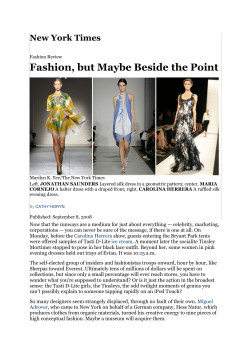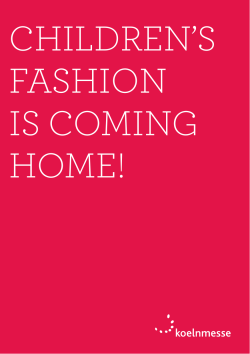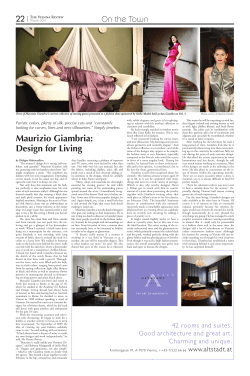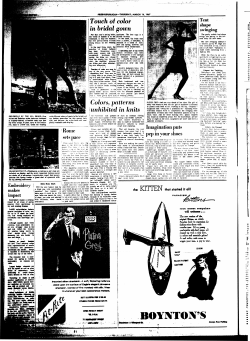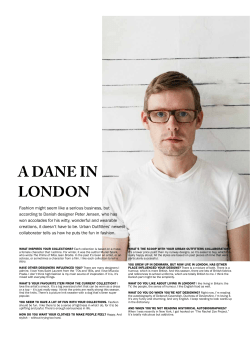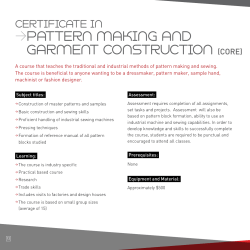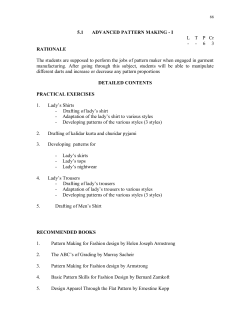
The 20 Century of American Fashion: 1900 – 2000 By Alison Kass
The 20th Century of American Fashion: 1900 – 2000 By Alison Kass Submitted in Partial Fulfillment of the Requirements for a Degree in Writing Journalism and Freelance 10 May 2011 Professor Anne Witkavitch WRT 465 Abstract This thesis project is a collection of articles that discuss American fashion during the 20th century. The articles are grouped by decade, starting in the year 1900 and finishing in the year 2000; with a double-decade piece for the beginning of the century. Fashion is an ever-changing, growing entity that connects with every person in the United States; some embrace it while others ignore it, yet fashion has a place in the American society that is constant. Through world wars and depressions, fashion takes on revolutionary hardships and transforms itself accordingly, becoming selections of style that fit every occasion, taste, and social standard. What happens in society is demonstrated in fashion. Coco Chanel quoted, “fashion is always of the time in which you live.” These articles correspond to and represent that. i Table of Contents Introduction 1 1900-1920s: The Beginning of Fashion in the 20th Century 5 1930s: The Great Depression and Hollywood Glamour 10 1940s: Women’s Workwear 13 1950s: Retro Beauty for Housewives and Pin-ups 17 1960s: A Fashion Revolution 20 1970s: Funky Style 24 1980s: The Edge of Fashion 27 1990-2000s: Fashion Goes Modern 31 ii The 20th Century of American Fashion: 1900 - 2000 Introduction Fashion designer Coco Chanel said, “Fashion is not something that exists in dresses only. Fashion is in the sky, in the street; fashion had to do with ideas, the way we live, what is happening” (“Famous Women and Beauty,” 2010). Coco Chanel’s quote is as pertinent today as it was back in the 1950s when she said it. Many see fashion as just frivolous clothing for anorexic-thin models, but fashion is also for the everyday woman with a discretionary income. The bottom line is that women want to look and feel good—the two are synonymous with one another. Chanel’s message resonates deeper than a classic suit jacket. Fashion is a part of who we are, the way we live, and the times we exist in—Chanel’s idea of fashion tied into ideas is a classic concept that spans decades. Fashion is not only defined by what we wear, but also how we carry ourselves. Those two things combined; clothing and attitude are what make up a personal style. Fashions and styles in America have changed dramatically over the decades in the past century. Fashion itself is an ever-changing collection of styles that suit different people and different times. Fashion can be viewed as an expressive art, with the human body as its canvas, and as a representation of 1 one’s class, career, imagination, and mood. But all fashions go in and out of style, which is evident in the vast changes seen in American clothing. There are many fads, yet other styles remain classics—clothing that sat in a woman’s closet in the 1950s, and remains in the wardrobes of women today. There are many factors that dictate which fashions come in and out of style in the United States. Many styles in the new millennium are inspired by the trends in past decades, and the trends in those decades were connected to what was going on in the country at that time. Crises in America profoundly affect what people wear, what they buy, and what they desire. The Great Depression in the ‘30s and early ‘40s heavily impacted what Americans bought and wore as clothing. Once people had to fight to feed their families, fashion became an unnecessary luxury, and was seemingly unimportant compared to other things in daily life. Fashion fell by the wayside for a few years during this time, but never vanished completely, because the lack of style actually then became the style of the time. New York City both mourns the 9/11 attacks and celebrates Fashion Week within the same block; half the crowd is dressed in structured black while the other sports Spring’s new lines of flowing silhouettes in pastel colors. This observable fact is an example of how fashion is part of life practices in the United States. 2 Once identified, fashion begins to change. This statement corresponds to the cultural, social, and psychological effects fashion has on the American people. As displayed in the articles ahead, styles come into fashion, catch on to the masses, and only stay for a short time until they dissipate when the next new, big thing comes along. The changes in fashion are motivated by culture and events, which in turn affect people socially and psychologically. Different styles embody different states of mind and events; the woman in white at a wedding is always the bride, as a white dress is culturally viewed as a fresh and innocent look, and as a new beginning. Conversely, at funerals and memorial services, the room is filled with people wearing all black outfits; this style represents the depressed or dark feelings people are having at the event. Fashion can be used as a synonym for glamour, style, and beauty. But more than any of these things, fashion should be seen as an expression. Every one is exposed to fashion every day, and every single person’s fashion differs somehow from another’s. Even those who do not give any thought to what they wear, or having a style, make choices in clothing that depict themselves as a person, and represent their character on a daily basis. The self-expression that comes from style allows people to be whoever they want to be. Fashion allows a person to change who they are based on their look. It is that expression that can boost self esteem, and allow the discovery of how one wants to present 3 themselves to the world as an individual. Fashion is an ever-changing, always growing, celebration of diversity in America. 4 1900-1920: The Beginning of Fashion in the 20th Century Figures 1-2; 1900 Corsets Figures 3-4; Flappers In the beginning of the 20th century, women in America began to embrace their personal styles. Before the 1900s, styles in America were very modest, and clothing was only used for cover from the elements. The 1900s marked the slow movement of fashion from simple body coverings to more defined silhouettes for women. 5 In the early 1900s, fashion was beginning to change into commerce. In the meantime, most women still wore full cover dresses that showed little to no skin. The attire was formal and very ladylike, with lace and ribbons, and big feathery hats. Women often changed their outfits several times a day depending on occasions in order to maintain proper etiquette. Underneath those frilly, full-cover dresses were tight fitting corsets. Corsets were underwear garments with long laces that were pulled and tied until a woman’s body was held in a tightly defined silhouette. Corsets were uncomfortable and meant to control how a woman moved and stood. If too tightly laced, which they often were, it restricted eating and breathing (Steele, 2001). No matter what type of garment, women’s clothing in the early 1900s was designed to show off a woman’s tightly corseted torso. Such tight fitting clothes required the perfect fit; many women went to dressmakers to be measured for their custom dresses. The most famous custom dressmakers of the time were the Tirocchi sisters. The sisters carefully constructed garments using dress forms built to their client’s exact measurements; they first made the lining, which was given to the client to try on to make sure it fit properly. After that step, the dressmakers then sewed the more costly fabrics around the lining, draping satin or velvet to form the skirt, and create a bodice using net, lace, and beaded trim (“Fashion in the 1900s). A girdle or belt held the waistline together. 6 Between 1910 and 1920, fashion began to loosen up. French designers like Paul Poiret looked to the French Empire for inspiration. He began designing dresses for an un-corseted figure, using loose, elegant draping. The clothes possessed softer lines and fell over a woman’s curves rather than forcing their bodies to conform to their clothing, as previous designers had done. By 1910, women began throwing away their corset undergarments. Poiret claimed that his dresses instigated the demise of the corset, but the truth is that many before him had already taken the first steps to eliminating corsets in their fashions. There had been a movement since the mid-19th century to abolish corsets (Steele, 2001). The trend towards looser gowns crossed the Atlantic to the United States, where American women adopted the new style. However, conservative women still hung on to their corsets for a few more years. When the World War I began in 1914, the couture business suffered a loss in business. Poiret and other designers were called into the military and forced to close their couture houses. Wartime prevented trade between France and the United States, so clientele in the couture business disappeared (“Fashion History Costume Trends and Eras,” 2009). As male designers were off defending France, a young female designer came of age. Gabrielle “Coco” Chanel was a pioneering fashion designer whose modernist philosophy and simple yet elegant design style helped her to become the most important figure in fashion in the 20 th century. She began making hats 7 and selling them in her boutique, which gradually expanded to include jersey dresses and menswear-inspired fashions. In a decade of wartime shortages, Chanel’s practical but expensive jersey outfits turned into an instant modern classic, appealing to wealthy clients because it made the rich look young and laidback (“Famous Women and Beauty,” 2010). In the aftermath of World War I, the United States entered a prosperous era. Social customs and morals became relaxed in the optimism brought on by the war’s end and the booming stock market. Women gained the right to vote in the 1920s and were entering the workforce in record numbers. The prohibition on alcohol was being ignored by many, and new music and dance came on to the scene. There was a revolution in almost every sphere of American activity, and fashion was no exception. Clothing changed with women’s changing roles in the modern society, particularly within the idea of freedom for women. Although women of a certain age still continued to dress conservatively, forward-looking younger women now made sportswear into the greatest post-war fashion. Women wore shorter skirts with pleats, gathers, or slits to allow motion to rule women’s fashion for the first time in the new century. Low waist dresses with fullness at the hemline allowed women to dance more freely. This design was the beginning of the flapper style, which became the ‘20’s biggest fad. Flapper dresses were often black, had a dropped waist, and were 8 fringed. The dresses also sometimes featured beading or sequined material. Flapper dresses were much more showy than the typical past decade dress. Women wore them with fitted bucket hats, covering their short curled hair, and low-heeled shoes. Women who wore this style of dress were called flappers, signifying a new breed of Western women who tended to show their contempt for what was considered appropriate behavior. They danced, cut their hair into short bobs, embraced liberalism, and were the beginning of women defying social and sexual norms in America. Fashion in the 1920s officially entered a more contemporary era of fashion design. Women continued to liberate themselves from the constricting clothes they had worn earlier in the decade and openly embraced more comfortable styles, like the shorts and pants put into style by Coco Chanel. The beginning of the century accomplished an important feat for women’s fashion that would shape the way clothing was seen and worn for the next hundred years. 1900 to 1920 began the movement on liberating women from the stuffy, matronly items women were obligated to wear in order to look like a proper lady. Soon, women were free of binding corsets, and more comfortable yet still flattering clothing was produced and worn without restraint. 9 1930s: The Great Depression and Hollywood Glamour Figures 5-6; Depression Fashion and Hollywood Star Mae West The Great Depression of 1929 left little in America’s 1930s unchanged, including fashion. The crisis of the economy profoundly affected what people bought, and therefore, what they wore. What seemed to be overnight, the highspirited, vivacious look of the flappers disappeared and, instead, mature sophistication became the mark of a fashionable woman. Looks were classless, ageless, and reasonable, all easy to wear and in affordable materials. Monetary hardships faced by Americans forced fashion back into a more conservative mode. Clothing during the Depression was usually comfortable pants and tops that women already owned prior to the Depression, since most did not have the 10 funds to buy anything new. Women needed to be dressed in order for them to move and work freely, so colors and fabrics did not much matter anymore. Once the Depression ended, trends slowly moved back towards a more feminine look. Starlets in Hollywood became the source of inspiration for women seeking style. Late 1930s fashion was fueled by Hollywood star’s glamour. Gucci scarves and sunglasses gained popularity for wealthy women. Elegant fabrics made their debut, as dresses were most often crafted of silk or satin and made to move with the body and hug its curves. These elaborately cut dresses epitomized the glamorous design of the era. While evening wear became more chic, daywear became sporty. Sport dressing gained popularity in the mid ‘30s. The decade was the first to see a true distinction between day and evening styles. During the affluence of the ‘20s, women could easily wear impractical clothing during the day without worry, as long as their domestic servants took care of the chores. However, the hard times of the Depression caused many women to do more work at home themselves, which necessitated practical clothing for the daytime. This further reflected the ‘30s streamlined design, as well as women’s new freedom to wear trousers. Simple skirts and pared-down outfits allowed for easy mobility in the daytime, while new fabrics such as metallic lamé became popular for more luxurious evening wear. The Depression motivated designers and manufacturers to produce clothing out of cheaper materials in order to save money. The newly improved 11 synthetic fabric rayon became an important part of many designers’ fashions, and cotton also moved into being more stylish clothing designs. This switch is still in practice today: cotton is the most popular fabric for clothing, and rayon is found in many clothing items in the present day (“The People History,” 2010). Despite the stock market crash, the Tirocchi sister’s business remained strong into the early 1930s. Customers continued to order sport dressing, evening gowns, afternoon dresses, and wool suits, but as the years went on they placed fewer orders, many of them were forced by circumstance. By the end of the decade, there were half as many customers as in the beginning. The Depression affected fashion profoundly, through designers and consumers, but the affluent celebrities kept fashion alive; stars were never more glamorous than they were in the ‘30s, with sparkly gowns, fur shrugs, and perfect curls. 12 1940s: Women’s Workwear Figures 7-9; Rosie the Riveter was a working woman’s icon In 1939, World War II began, but fashion still had its place, even again in a time of war. As America entered the landscape of war, fashion responded to the restrained mood and economy. This shift in all aspects of life provided a change in clothing that would revolutionize how clothes were manufactured and sold to the American public. In the meantime, the drabness and uniformity of clothing was inevitable, as people were encouraged to make do with the clothing they already owned and mend whatever old pieces they had. Service uniforms were constantly worn by both men and women at all types of social events. The reality of the war became impossible to ignore as military style became the most popular trend in clothing. 13 In all the countries at war, fashion took a second place to providing basic necessities to the men and women in the armed forces. Many factories that made clothing were closed to help in the war effort by producing military supplies. The remaining fashion houses worked with restrictions on how much fabric could be used in any garment, and consumers had to fit clothing into their allotments of ration coupons. All types of cloth were needed during the war for a variety of purposes, so material for clothing was severely rationed. Women were issued a limited number of ration coupons to use for clothing purchases each year, and this number declined steadily as the war progressed. Due to the limited number of materials, fashions of the decade emphasized shorter skirts than ever before, solely because they used the least amount of fabric to make. Buttons for any type of apparel were limited to three per clothing item. Nylon stockings, which were very popular, became scarce, so women began wearing just ankle socks or showing their bare legs. During the war and its aftermath, there was rarely an adequate amount of any clothing item available, so women were forced to be creative, and dressed as femininely as they could with the items that were available. Paris fashion trends have always been followed in the United States, but travel difficulties meant that American designers were receiving more attention from the public and press than ever before. In France, most couture houses kept going until the German army occupied Paris. Some couturiers then closed down, 14 while others changed location—many moving from Paris to open stores in America. As soon as Paris was liberated by Allied forces, fashion editors began to show French designs in magazines again. When French designer Christian Dior reacted against the deprivation of the war by showing off his new looks, Paris couture was again the leader in fashion. However, American ready-to-wear clothing had become very well-liked, and American designers then began to take a more prominent place in the world of fashion, which they still hold today (“The People History,” 2010). Women’s fashion changed dramatically from the silk gowns of the ‘30s to practical pants for the working woman in the ‘40s. Women were now full-fledged members of the work force, and designers came out with the ultimate practical clothing to accommodate this shift in occupation. Women began wearing pants or overalls, and tying their hair up in scarves for work. By the late 1940s, designers had grown tired of the utilitarian minimalist clothing of the wartime era. Women were longing for the luxuries that had been suppressed during the years of the war, and they began to creep back out in fashion during the late ‘40s. Styles featured rounded shoulders, full skirts, and narrow waists. The garments were lined with expensive fabrics, and ornate accessories became necessary items to make an outfit complete and fashionable. Although critics complained about the extravagance of clothing while rationing was still mandated, women throughout the country yearned for the revitalization 15 of femininity. And it would prove to be popular enough to last well into the 1950s. 16 1950s: Retro Beauty for Housewives and Pin-ups Figures 10-11; 1950s Pin-up girls Figures 12-13; Poodle Skirt/Housewife This retro decade’s fashion exploded for women in terms of fabrics. In 1950, following the end of World War II, rations on all items used to make clothing were lifted, so clothing was able to be produced more freely, which sparked a frenzy of newly produced items in a more broad style range. There were two specific eras of style in the ‘50s decade. The early ‘50s were devoted to poodle skirts and modest white blouses with black and white Oxford shoes. Women preferred to look young and innocent into their 20s, with 17 ribbons tied in their curled ponytails. Common styles in this time period were poodle skirts, which were originally designed by Christian Dior, cardigan sweaters, a boyfriend’s varsity jacket, and white folded socks with Oxford or Mary Jane shoes. While the poodle skirts and sock hop dances were for younger females, older women dressed smartly, had good grooming habits and a tailored look. In this decade, acting and looking like a lady was something taught to girls from a very young age, and wearing dresses on a daily basis was a given. Girls grew up to be housewives; once their husbands came home from work, they looked impossibly beautiful, dressed without a wrinkle, all while having a full meal on the table for dinner. Swing skirts on dresses were most popular for the ‘50s housewife, which had a tight fitting waist with the skirt splayed out from that point. Another popular skirt style was the pencil skirt. The goal with this style was to create an hourglass shape, and girdles were often worn underneath these types of dresses. The pencil skirt was a straight, tight-fitting skirt for older women, as it was seen as too provocative for younger girls. Dresses often had bolero sleeves, and were in floral prints. Popular accessories for women were cat-eye glasses, which are still a popular style in glasses for women today. Later in the ‘50s era, America was overflowing with glamour. The style moved more towards a sexy, but still very feminine look, with women emphasizing their hourglass shapes even more than the pencil skirt allowed. The 18 classic pin-up girl emerged as an art form before it became an actual style, and the art of seduction is what drove this culture to emerge. Pin-ups were photographs of celebrities who were considered sex symbols. Pin-ups were artwork, often depicting idealized versions of what some thought a particularly beautiful or attractive woman should look like (Buszek, 2006). The pin-up was a uniquely American art form, and the style is still practiced in great popularity today. The 1950s was the time when female sexuality became much more acceptable to portray, whether it was through calendars, advertisements, or walking down the street. Marilyn Monroe and Bettie Page were in full swing in Hollywood, being the most beautiful and sexually attractive woman to men at that time, so naturally, other women wanted to follow. The pin-up style was complete with black winged eyeliner, full red lips, and filled-in eyebrows with high arches. Even beauty marks were drawn on the face to look like Marilyn Monroe. Women stressed the smallness of their waists when dressing, and like what was done with corsets in the 1920s, busts and backsides were glorified as much as possible. Bathing suits, lingerie, and shorts were commonly high-waisted. When it came to shoes, high heels and fishnet stockings were a must for a pin-up (Buszek, 2006). 1950s fashion is one of the styles that had the biggest comeback in the new millennium. Retro looks are a big part of fashion today for celebrities as well as the everyday woman. 19 1960s: A Fashion Revolution Figures 14-15; Hippie and Mod Styles The 1960s in America were a time of change, and the fashion world was not excluded from this. The fashion revolution in the ‘60s witnessed an explosion of youth that again changed styles completely. The Western world began to rebel against the runway collections of designers in Paris and create their own trends instead. Designers then followed their creations and desperately tried to include them into clothing for the masses (“The People History,” 2010). This era is when the ever-popular wardrobe staple of blue jeans became the fashion staple that it is today. By far, the most popular clothing item in the ‘60s was bell-bottom jeans, and the style became somewhat androgynous, as it became perfectly normal and 20 acceptable for women to wear jeans on a daily basis at this time. Available clothing had become very diverse, and women could pick and choose which styles complimented them and their own personal taste, rather than there being just one or two major trends to follow. Women really began to develop their own styles, combining fads and colors to make outrageous combinations that represented their individuality. This type of dress was encouraged, as manufacturers made many diverse pieces. The freedom of choice inspired by this decade would live on, and make fashion the fusion of styles and love of eccentricity that it is today. In the early ‘60s, ‘50s fashions of bouffant dresses and beehive hair carried over, but did not last. Beatnik fashions quickly took over, which included looks with black berets, black slacks, and dark glasses. Women wore flat shoes during this time, and often dark eye makeup. The ‘60s did not start out with the psychedelic prints it is known for. Most clothing stores carried items that were somewhat monotonous and marketed toward older women. Then, little shops called boutiques opened, and began selling cheap and colorful clothing to teens and younger women. The stores also sold fun items like leather knee-high boots, miniskirts, and fake eyelashes. Girls snapped up the budding fashions in the boutiques, and thus the demand for more fashionable clothing for younger women became evident to retailers (“The People History,” 2010). 21 Go-go dancers originated in the early ‘60s when women began to get up on tables at nightclubs and do the twist. There were so many women wearing gogo boots, another ‘60s fashion fad, to clubs that night promoters in the mid ‘60s conceived the idea of hiring women to entertain club-goers with their dancing (“The People History,” 2010). Popular styles included and ranged from hot pants, which were extremely tight and short shorts, miniskirts, short printed dresses with bell sleeves, space age fashions in vinyl and other synthetic materials, bold and solid color-blocked clothing from the pop-art movements, which were commonly referred to as mod fashions, madras plaids, oversize sweaters, and matching accessories. Hats and gloves were no longer appropriate daywear as they were in preppy and ladylike fashions of earlier decades. Approaching the middle of the decade, the space age clothing trend became popular. Metallic and neon colors were used, as well as metal and plastic adornments. The hippie subculture was originally a youth movement that rose up in the United States in the mid ‘60s. In 1966, psychedelic clothing became a hit. Acid colors were brighter and bolder than ever before, and clothes were never short of loud patterns. The decade ended with the melding of the psychedelic trend to the hippie look, which would take off in the 70s. Hippie fashions consisted of bellbottom jeans or maxi dresses, peasant blouses, fringed vests, flower patches, headbands, and sandals. Much of hippie clothing was purchased at Army Surplus 22 stores or sewn by women using macramé details or beading. Real flowers were often worn in women’s hair, coining the term “flower child.” Most jewelry was handmade, but store-made pendant peace signs worn around the neck were very popular within hippie culture. The 1960s were a time of transformation in every aspect of American life. The move was from conservative Jacqueline Kennedy dress suits to dirty blue jeans. These volatile changes in taste and fashion, of course, mirrored what was happening in society as a whole, as it always seems to do. 23 1970s: Funky Style Figures 16-17; 70s Fashions of lace-up boots, bell-bottoms, and flower-power Fashion in the 1970s went through an experimental phase after the psychedelic-style clothing from the ‘60s carried over. Much of the hippie style had been integrated into the mainstream American society by the early ‘70s. However, by the mid ‘70s, with the end of the draft and the Vietnam War, the media lost interest in the hippie counterculture. Instead, there was a revival of the mod subculture, and the emergence of new youth cultures like skinhead and punk styles gained popularity. In early ‘70s fashion, straight and flared empire line dresses with belled sleeves were the style for dressy occasions. Another frequently worn dress style was the granny dress; the dress had a high neck which was trimmed with lace. 24 Granny dresses were commonly floral printed. Also in the early ‘70s, platform shoes began to grow in inches, starting out at ¼ inch and maxing out at four inches at their peak of popularity. Other popular ‘70s styles included bell-bottom jeans, which had a huge comeback in the ‘90s and can still be found on store racks and women all over the country today. ‘70s style had a bohemian influence, with women wearing peasant tops with embroidery and belled sleeves, large floppy hats, leather sandals, and maxi dresses. Miniskirts of the ‘60s were replaced with shorts and tucked-in blouses, silk scarves, wooden heels and chunky jewelry. The ‘70s did still have a large hippie influence, which combined easily with the bohemian style. Women’s hair was long, and almost always parted straight down the center. The mood of the 1970s was giddy with happiness for the war being over, and people wanted to celebrate. The fashion scene as disco parties during this era became indelible in ‘70s culture. Disco fashions were trendiest in the late ‘70s, and is the most memorable and popular style of the decade. Platform shoes and tight bell-bottom jeans, shiny polyester outfits, and colorful patterns will always be associated with the disco era as fashion during this time helped revolutionize the disco culture. The base of fashion built in the ‘70s influences many facets of the industry today. The use of synthetic fabrics like rayon and polyester popular in disco 25 clothing became one of the main fabrics used in the clothing industry in the new millennium. Women chose to be whoever they wanted to be, and wore whatever they felt like wearing; a short mini skirt one day, a long maxi dress the next. Women’s carefree outlook on getting dressed coincided with how women today dress themselves—it’s all about the feeling. The move away from traditional, conservative clothing of prior decades solidified in the ‘70s, helping redefine acceptable standards in women’s clothing for all future fashion to come. 26 1980: The Edge of Fashion Figures 18-20; 80s Punk, Legwarmers, and Madonna When 1980s fashion is thought of, many different styles come to mind: fashion in the ‘80s was a melting pot of personal styles; multiple trends were combined in different ways to form one’s own look. Of all the decades in the past century, ‘80s fashion is remembered with the most outrageous styles. Subtlety in fashion was never practiced—everything was the bigger the better. Big hair, 27 heavy makeup, pounds of metal jewelry and pearls, and mixed bright colors are trademark styles of ‘80s fashion. While high fashion greatly declined in the ‘60s and ‘70s, designer trends were back in the ‘80s. New York boutiques and Paris runway shows were flooded with American women looking to get their hands on the most sought after fashions straight from designer lines. Money dominated much of the style in the ‘80s, with mass producers replicating high-end clothing for the middle and lower classes. Similarly to present time, fashion was centered on top designer clothes and accessories, while everything else seemed to just be a duplicate of that. Clothing was a sign of power for many women. Women wore expensive business suits to work to be seen as authoritative and dominant. By night, extravagant gowns portrayed a woman’s femininity and glamour. A trend that was happy to be forgotten for over 10 years but which recently has surfaced again in the fashion world is the iconic ‘80s shoulder pads. Some women wonder why they would ever want their shoulders to appear bigger; but in the ‘80s world of money and power, large shoulders on women asserted that they were powerful as well. Punk fashion trends were a big fad in the ‘80s. Contrary to the wealthy women in cocktail dresses, teens and party-goers donned leather, bold neon colors, big hair, and heavy makeup. Silver and gold jewelry in crosses, chains, and pearls were stacked on as necklaces and bracelets. This trend was originated by Madonna’s music videos. The creation of MTV revolutionized how fashion 28 and music came together, inspiring one another throughout the decade. With MTV airing music videos, American teens could see how their favorite celebrities and musicians dressed and could then copy their styles in their own unique ways. Perhaps one of the most influential trends from the ‘80s that has resurfaced in the present day fashion world is leggings. Leggings were a wardrobe staple for women in the ‘80s, and still a staple for women today. The difference is in the way they are worn: leggings in the ‘80s were almost always brightly colored in a spandex material, textured, or had stirrups, while today, leggings are most popular in basic black cotton-stretch or leather. Today, leggings are worn with tunic tops, a shirt that extends below the backside, and is considered the appropriate way to wear leggings, where as in the ‘80s, it was common for women to wear their leggings with cropped tops, which was not considered a fashion faux pas as it is today. Another popular way to wear leggings in the ‘80s was with a pair of leg warmers on top. Leg warmers were also a big fad of the decade. Leg warmers are basically thick socks without feet, and were found in the drawers of every woman who had any bit of fashion sense in the ‘80s. Leg warmers originated long before the ‘80s fashion trend for dancers to wear to keep their legs warm. When the movie Flashdance debuted in 1983, leg warmers moved from function to fashion, and were worn with everything, including miniskirts, leggings, and parachute pants. Leg warmers were a fashionable woman’s favorite accessory. 29 Another Flashdance style that gained popularity in the ‘80s and came back on trend in the present day is off-the-shoulder tops. Women cut wider necklines in their shirts and sweatshirts in order for the top to drape off the shoulder. Today, shirts are manufactured to be cut as off-the-shoulder tops, so there is no need for scissors. The fashion from the ‘80s is without a doubt one of the most interesting and eccentric decades, because there was no fear or repercussion by trying something new. 30 1990-2000s: Fashion Goes Modern Figures 21-22; Denim and Louis Vuitton Bag The end of the century’s fashion is as opposite as it gets to the fashion in the beginning of the century, but the concept is the same; fashion is a tool used to individualize, to raise esteem, and to make a statement. These facets exceed time, and apply to all the fashion styles throughout the decades of the 20th century. 31 The punk style popular in the ‘80s evolved into the grunge style of the ‘90s. Alternative music ruled the air waves, and the rocker style gained popularity. Denim, most often ripped and distressed, was at the forefront of the grunge fashion movement. The rising world of hip-hop also became a big influence in ‘90s fashion, inspiring baggier fitting pants for women as well as men. Whatever its expression, comfort was the key factor in clothing choice for most women in the ‘90s. The decade began to reject the moneyed styles of designers and opt for more causal wear. Work place attire, while still being professional, relaxed its standards somewhat and had freer policies in dress code, allowing women to break free from the business suits of the ‘80s and have more of a personal style while on the job. Preppy clothing came into fashion by designer Tommy Hilfiger, whose all-American look dominated department store sales. Sweater vests, turtlenecks, blouses, khakis, and a palette of pink, green, and white filled closets across the country. The preppy look was associated with being an all-American girl, and in school settings, popularity. The ‘90s preppy style was the opposite of another style that gained recognition in the decade. Again, from the music videos young girls watched, the vibe became more sexualized, suggestive, and fashion-forward. Belly shirts for teens came into the limelight, with hems rising on skirts and skorts alike. Females 32 who dressed in this type of attire were considered inappropriate, especially in school settings, where it frequented. Many girls would wear their preppy school clothes during the day, and then change into more revealing outfits at night. This type of dress was discouraged among teens, as it lowered morals in the eyes of adults and guardians. This began the issue that still goes on in the present day; females being exposed to sexuality at a young age through the media, and then wanting to appear more mature by dressing sexy. Low rise pants, which are almost the only kind of jeans bought and sold in the present day, originated during this time. Heels became higher, adding platforms and starting to morph into what now is the ever popular and classic stiletto heel. The ‘90s was a time in which the nation grew more independent, and different categories of style emerged. Women could choose their look, whether it be grunge or preppy, and feel empowered by their personal style no matter which category it fit into. The 2000s are often described as a mash-up decade. The decade did not have one or two particular styles like prior ones, but a multitude of fashion styles that included recycling fads from past decades, and calling it vintage. Many other styles from the ‘90s also continued on into the ‘00s, but just became more refined. The overall styles of the 2000s are best described as polished versions of earlier fashions, honing in on the basics to create new styles that were inspired by the past. 33 Designer clothing and accessories were once again at the forefront of fashion, just as they had been in 1920 with Coco Chanel. Fashions revive and renew over the decades. Works Cited Buszek, M. E. (2006). Pin-up grrrls: feminism, sexuality, popular culture. Durham: Duke University Press. Coco Chanel Biography. (n.d.). Famous Women and Beauty. Retrieved February 15, 2011, from http://www.famous-women-and-beauty.com/coco-chanelbiography.html Fashion History Costume Trends and Eras, Trends Victorians - Haute Couture. (n.d.). Fashion History Costume Trends and Eras, Trends Victorians Haute Couture. Retrieved February 15, 2011, from http://www.fashionera.com/index.htm Fashion in the 1900s. (n.d.). The A. & L. TIROCCHI DRESSMAKERS PROJECT. Retrieved February 15, 2011, from http://tirocchi.stg.brown.edu/514/story/fashion_earlycentury.html 34 Fashions and Clothes Styles from 50 years what do you remember. (n.d.). Where People, History and Memories Join Together from The People History Site. Retrieved February 15, 2011, from http://www.thepeoplehistory.com/fashions.html Goldberg, N. (2005). Writing down the bones: freeing the writer within (2nd ed.). Boston: Shambhala. Hoobler, D., & Hoobler, T. (2000). Vanity rules: a history of American fashion and beauty. Brookfield, Conn.: Twenty-first Century Boosk. Scheips, C. (2007). American fashion.. New York: Assouline. Steele, V. (2001). The corset: a cultural history. New Haven: Yale University Press. Pictures Figures 1-2; 1900 Corsets http://www.antiquecorsetgallery.com/article.php?article=46 Figures 3-4; Flappers http://ourimages.co.cc/the-flappers-of-the-1920s.html Figure 5; Depression Fashion http://rumorsrva.blogspot.com/2009/01/dressing-in-recession.html Figure 6; Hollywood Glamour of Mae West 35 http://www.zimbio.com/1930%27s+Hairstyles/articles/7/1930s+Style+Icon+Mae +West Figure 7-8; Working Women http://emergewithstyle.blogspot.com/ Figure 9; Working Women http://www.ehow.com/info_8132071_ladies-clothes-1940s.html Figure 10; 1950s Pin up girls http://www.theage.com.au/news/Arts/Turning-the-older-cheek-onporn/2005/05/27/1116950831674.html Figure 11; 1950s Pin up girls http://hereshesat.blogspot.com/2011/04/n-is-fornineteen-forties.html Figure 12; Poodle Skirt http://www.flickr.com/photos/detroitinstituteofarts/3969366635/ Figure 13; Housewife http://echostains.wordpress.com/tag/nostalgia/ Figure 14; Hippie http://fashionheroines.blogspot.com/2010/11/inspirations-sixties-revolutionfrom.html Figure 15; Mod http://www.bloglovin.com/en/blog/1767900/mod-fox-1960s-inspired-fashion Figures 16-17; 70s Fashion http://partyfashion.tripod.com/id6.html Figure 18; Punk http://dressingupindaisies.onsugar.com/Through-Decades-1980s-fashion8256961?page=0,0,1 Figure 19; Legwarmers http://www.thecheapdesignerpurses.com/blog/1980s-fashion/ Figure 20; Madonna 36 http://www.80s-fashion-fancy-dress.com/80s-madonna-look.html Figure 21; Denim http://www.fashionbehindthescenes.com/denim-fashion-trends-of-the-seasonspring-summer-2010/ Figure 22; Louis Vuitton Bag http://www.okchaneloutlets.com/louis-vuitton-bag-a040-p-497.html *All taken from Google Images. All used without permission. 37
© Copyright 2025

